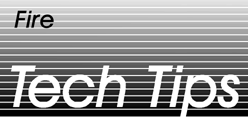 |
 |
Technology & Development Center |
| May 2004 | 5100 | 0351–2323-MTDC |
The Missoula Technology and Development Center (MTDC) developed a detachable face and neck shroud to protect wildland firefighters from radiant heat without compromising work performance or comfort. The shroud was developed after face and neck shrouds and balaclava-style hoods were tested at the University of Montana Human Performance Laboratory in Missoula, MT.
Firefighters should not use the face and neck shroud to work in areas that are more dangerous than those they would work in without the shroud. Do not proceed with assignments that are too risky just because you are wearing or carrying personal protective equipment such as the face and neck shroud.
The new face and neck shroud was designed with the same Nomex material as the yellow Nomex shirt worn by wildland firefighters. It attaches to a hardhat easily with its hook and pile (Velcro) fastener (figure 1). When the shroud is not needed, it can be removed or rolled outside of the hardhat and fastened to itself above the bill (figure 2). When the shroud is being used, firefighters can secure it around their throat and face using the hook and pile fastener sewn to the front of the shroud (figure 3). For maximum protection, firefighters should adjust the shroud to fit comfortably loose. The face and neck shroud meets requirements set by the National Fire Protection Association (NFPA) Standard 1977, Protective Clothing and Equipment for Wildland Firefighters.
Figure 1—Attaching the shroud
to the helmet using the
hook and pile fastener.
Figure 2—Shroud rolled over the helmet brim.
Figure 3—Shroud unrolled to protect the face and neck.
Because firefighters are statistically more likely to suffer from heat stress than to be injured by radiant heat, MTDC has designed personal protective clothing primarily to let body heat escape, rather than to shield workers from the heat of a fire. The face and neck shroud is not intended to be worn continuously, because it would interfere with the body’s ability to cool itself efficiently. The shroud is not an airway filter, and has only a limited ability to protect firefighters from smoke, ash, or other small particles.
You should wear your shroud during entrapments, when moving past areas of intense heat, or when leaving other situations that occur suddenly (such as when a fire flares up). Do not use your face and neck shroud to remain in places that are hotter than you could tolerate otherwise.
Exposed skin is your best indicator of extreme temperatures. Do not cover your most reliable thermometer—the exposed skin on your face and neck—unless you must.
Lori Messenger joined her first fire crew at the Boise National Forest in 1997, then moved to the Union Hotshots. She became a Missoula smokejumper in 2000, after receiving her master of fine arts degree in creative writing from the University of Pittsburgh. Lori has spent many winters coaching cross-country skiing and teaching creative writing to young people. During the spring of 2003, she began teaching basic firefighting classes in Missoula. She completed a part-time detail at MTDC that summer.
Tony Petrilli is an equipment specialist for the fire and aviation and safety and health programs at MTDC. He has a bachelors degree in education from Western Montana College. Tony began working for the Forest Service in 1982 and joined the center full time in 2000. He has worked as a firefighter on the Lewis and Clark and Beaverhead National Forests and as a smokejumper for the Northern Region. He is also a division/group supervisor and type III incident commander.
For further technical information, contact Tony Petrilli at MTDC.
E-mail: apetrilli@fs.fed.us
The Forest Service, United States Department of Agriculture (USDA), has developed this information for the guidance of its employees, its contractors, and its cooperating Federal and State agencies, and is not responsible for the interpretation or use of this information by anyone except its own employees. The use of trade, firm, or corporation names in this document is for the information and convenience of the reader, and does not constitute an endorsement by the Department of any product or service to the exclusion of others that may be suitable. The U.S. Department of Agriculture (USDA) prohibits discrimination in all its programs and activities on the basis of race, color, national origin, age, disability, and where applicable, sex, marital status, familial status, parental status, religion, sexual orientation, genetic information, political beliefs, reprisal, or because all or part of an individual’s income is derived from any public assistance program. (Not all prohibited bases apply to all programs.) Persons with disabilities who require alternative means for communication of program information (Braille, large print, audiotape, etc.) should contact USDA’s TARGET Center at (202) 720-2600 (voice and TDD). To file a complaint of discrimination, write to USDA, Director, Office of Civil Rights, 1400 Independence Avenue, S.W., Washington, D.C. 20250-9410, or call (800) 795-3272 (voice) or (202) 720-6382 (TDD). USDA is an equal opportunity provider and employer.
|
| topTop |
| USDA Forest Service, Technology and Development Last Modified: 10/15/2016 23:43:23 |